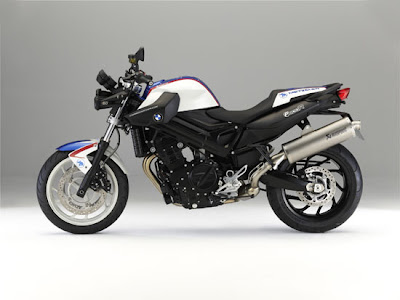
2010 KTM 690 SMC Supermoto

2010 KTM 690 SMC Supermoto
2010 KTM 690 SMC - Specifications
MSRP: See Dealer
Engine type Single cylinder, 4-stroke
Displacement 654 cc
Bore x stroke 102 / 80 mm (4.02 / 3.15")
Performance (homologated) 46.3 kW / 7500 rpm
Max. torque 64 Nm / 6000 rpm
Compression ratio 11.8:1
Starter/Battery E-Starter / 12 V 8.6 Ah
Transmission 6 gears, dog clutch engagement
Fuel Mixture Generation Keihin EMS with EPT (Electr. Power Throttle)
Control 4 V / OHC with roller rocker levers
Lubrication Pressure lubrication with 2 oil pumps
Engine lubrication Motorex, fully synthetic, SAE 10W-60
Primary drive 36:79
Final drive 16:42
Cooling Liquid cooled
Clutch APTC slipper clutch, hydraulically operated
Ignition Keihin EMS
Frame Chromium-Molybdenum trellis frame, powder coated
Subframe Self-supporting plastics tank
Handlebar Aluminium, Ø 28 / 22 mm (1.10 / 0.87"), tapered
Front suspension WP USD Ø 48 mm (1.89")
Rear suspension WP mono shock with Pro Lever Linkage
Suspension travel front/rear 275 / 265 mm (10.83 / 10.43")
Front brake Brembo four piston, radially bolted caliper, brake disc Ø 320 mm (12.6")
Rear brake Brembo single piston, floating caliper, brake disc Ø 240 mm (9.45")
Rims, front/rear Spoked wheels with aluminium rims 3,5 x 17"; 5 x 17"
Tires, front/rear 120/70 ZR 17; 160/60 ZR 17
Chain X-ring chain 5/8 x 1/4"
Main silencer Stainless steel silencer with regulated catalytic converter
Steering head angle 63°
Trail 112 mm (4.41")
Wheel base 1480 ± 15 mm (58.27 ± 0.59")
Ground clearance (unloaded) 290 mm (11.42")
Seat height 900 mm (35.43")
Tank capacity approx. 12 liters (3.17 gal) / 2.5 Litre Reserve (0.66 gal)
Weight (no fuel) approx. 139.5 kg (305.4 lbs)












































